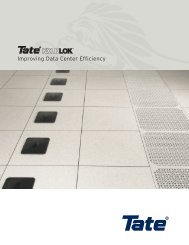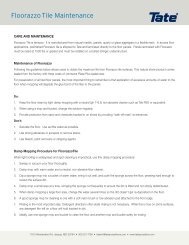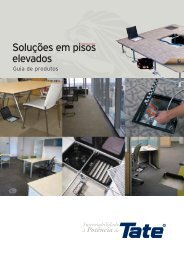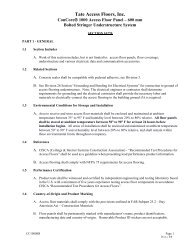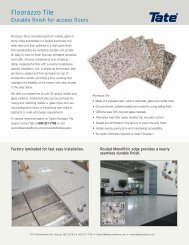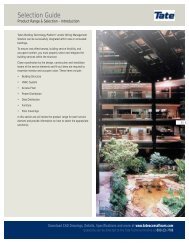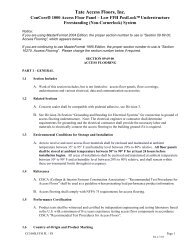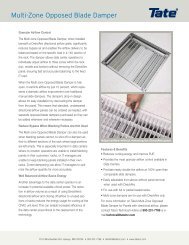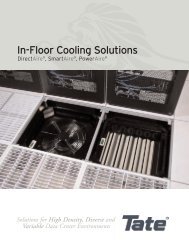Tate Access Floors, Inc.
Tate Access Floors, Inc.
Tate Access Floors, Inc.
Create successful ePaper yourself
Turn your PDF publications into a flip-book with our unique Google optimized e-Paper software.
<strong>Tate</strong> <strong>Access</strong> <strong>Floors</strong>, <strong>Inc</strong>.FF 3000 Heavy Duty Aluminum Panel and UnderstructureNotice:If you are using MasterFormat 2004 Edition, the proper section number to use is “Section 0969 00, <strong>Access</strong> Flooring”, which appears below.If you are continuing to use MasterFormat 1995 Edition, the proper section number to use is“Section 10270, <strong>Access</strong> Flooring”. Please change the section number below if required.PART 1 - GENERAL1.1 Section <strong>Inc</strong>ludesSECTION 09 69 00ACCESS FLOORINGA. Conductive raised-access flooring and accessories for a Class ____ Clean Room.1.2 ReferencesA. Applicable Standards: Refer to the following applicable standards:1. NFPA 99 – National Fire Protection Association Health Care Facilities; Electrical ResistanceCriteria.2. Federal Standard Test Method 101C Method 4046.3. ASTM E595-93 – Total Mass Loss and Collected Volatile Condensable Materials FromOutgassing in a Vacuum Environment.4. ANSI/ESD-S7.1-1994 – ESD Association Standard for Protection of Electrostatic DischargeSusceptible Items – Resistive Characterization of Materials Floor Materials5. AATCC-134 – Electrostatic Propensity6. ASTM D3359 – Method for Measuring Adhesion by Tape Test7. ASTM D3363 – Test Method for Film Hardness by Pencil Test8. UNS A03800 – Unified Numbering System Aluminum Alloy Specification9. ASTM SC84B (formally ASTM B85) – Aluminum Alloy Specification10. UNS A03830 - Unified Numbering System Aluminum Alloy Specification11. ASTM SC102 - (formally ASTM B85) – Aluminum Alloy Specification1 R-11/08
Downward flow with Damper at 100% open 558 cfm at .1" of H 2 ODownward flow without Damper 634 cfm at .1" of H 2 O11/32" dia. 1024 Chamfered holes (Vinyl Tile only) Holes chamfered to a 3/32 inch radiusDownward flow with Damper at 100% open 960 cfm at .1" of H 2 ODownward flow without Damper 1081 cfm at .1" of H 2 O13/32" dia. 1024 Standard holes – 23% open area (Vinyl Tile only)Downward flow with Damper at 100% open 764 cfm at .1" of H 2 ODownward flow without Damper 868 cfm at .1" of H 2 OF. Axial Load [Specify 1 or 2.]1. Aluminum pedestal head assembly with aluminum pedestal base assembly shall provide aminimum 10,000 lb. (4536 kg) axial load without permanent deformation.2. Aluminum pedestal head assembly with steel pedestal base assembly shall provide aminimum 10,000 lb. (4536 kg) axial load without permanent deformation.G. Overturning Moment:1. Aluminum pedestal head assembly with aluminum or steel pedestal base assembly shallprovide an average overturning moment of 1000 in-lbs. (113 N-m) when bonded to a clean,sound, unsealed concrete surface. Mechanical fasteners can achieve higher overturningmoments.J. Stringers: [Specify stringer or stringerless.]1. Shall be capable, without panels in place, of supporting a concentrated load of 200 lbs. (91kg) at the center of the span with a permanent set not to exceed .010 inch (.25 mm) after theload is removed.K. Electrical Grounding Criteria: [Specify Section A, B, or C.]1.6 Quality AssuranceA. Conductive floor covering resistance of not less than 25,000 ohms (2.5 x 10 4 ), nor more than1,000,000 ohms (1.0 x 10 6 ), measured across surface of floor covering through panel tounderstructure. Please specify NFPA 99 (500 volts) or ESD 7.1 (100 volts) test method.B. Static dissipative floor covering resistance of not less than 1 x 10 6 ohms nor more than 1 x 10 8ohms, measured across surface of floor covering through panel to understructure. Pleasespecify NFPA 99 (500 volts) or ESD 7.1 (100 volts) test method.C. Anti-static floor covering shall have typical resistance test values of 1.0 x 10 6 ohms to 2.0 x10 10 ohms, measured across surface of floor covering through panel to understructure as testedper NFPA 99.D. Conductive epoxy powder coating resistance of not less than 25,000 ohms (2.5 x 10 4 ), normore than 1,000,000 ohms (1.0 x 10 6 ), measured across floor surface through panel tounderstructure per ESD 7.1 (100 volts) test method.A. Construction Managers Quality Assurance Responsibilities: Construction Manager is solelyresponsible for quality control of the work.3 R-11/08
B. Manufacturer’s Qualifications: Manufacturer shall have been engaged in the fabrication of accessflooring of types and sizes required and whose products have been in satisfactory use in similarservice for not less than 10 years. Like items of material provided herein, shall be the products of onemanufacturer in order to achieve standardization for appearance, maintenance and replacement.C. Installer: <strong>Access</strong> flooring installer shall be trained, approved by the floor system manufacturer andshall have successfully completed within the last three years, at least (3) three installations similar intype and size to that of this project.D. [Optional] Field Samples: Prior to the Pre-Construction Conference, provide a field sample of accessflooring, not less than 100 square feet in an area designated by the Architect/Engineer. Utilize thesame materials and installation methods in the sample as required for the final work. Sample areasshall serve as the standard for materials, workmanship and appearance for such work throughout theproject and shall remain apart of the final work.E. Pre-Installation Meeting: Prior to installation of the Clean Room <strong>Access</strong> flooring system, and atConstruction Manager’s discretion, meeting shall be held to coordinate <strong>Access</strong> Floor System workwith other trades. Meeting shall include Owner, Architect/Engineer, Construction Manager, accessflooring system Contractor, and other subcontractors whose work requires coordination with theClean Room access flooring system.1.7 Delivery, Storage and Handling1.9 SubmittalsA. All access floor panels and understructure must be cleaned, inspected and packaged in a clean anddebris free environment.1. [Optional] Cleanroom pack for panels: Panels shall be individually cleaned and individuallypacked within a moisture absorbing plastic bag sealed with tape. The panels shall then placed ona pallet with plastic sheet separators between each bagged panel to prevent damage to bags. Theentire stack shall then covered in a plastic bag and cardboard corner protectors shall be added tothe corners. A cardboard sleeve shall be used to cover the entire stack of panels and shall thenbe banded tightly. [Specify Cleanroom pack.]2. [Optional] Cleanroom pack for understructure: Understructure shall be individually cleaned andpacked within a shipping carton lined with a moisture absorbing plastic bag. Plastic sheetseparators shall be placed between layers of understructure. The bag shall be sealed and thecarton shall be closed and tightly banded. [Specify Cleanroom Pack.]B. Deliver and store materials in their original unopened packages.A. Provide samples of each type of floor panel and pedestal illustrating finishes and color.B. Detail sheets, for each proposed product type, which provides the necessary information to describethe product and its performance.C. Test reports, by an independent testing laboratory, certifying that component parts perform asspecified.PART 2 - PRODUCTS2.1 Manufacturers4 R-11/08
A. TATE ACCESS FLOORS, INC.B. Alternative products shall meet or exceed all requirements as indicated herein and must receive priorwritten approval by the architect or designer.C. <strong>Access</strong> floor manufacture shall be ISO9001: 2000 certified demonstrating it has a robust and welldocumented quality management system with continuous improvement goals and strategies.D. <strong>Access</strong> floor manufacturer’s facilities shall be ISO14001:2004 certified demonstrating that theymaintain an environmental management system.2.2 Support Components [Specify All Aluminum or Aluminum/Steel Pedestals]All Aluminum Pedestal Assembly:A. Aluminum Pedestal Head Assembly:1. Pedestal assemblies shall be corrosive resistant, all aluminum construction, and shall provide anadjustment range of +/- 1" for finished floor heights 9" or greater.2. Pedestal assemblies shall provide a means of leveling and locking the assembly at a selectedheight, which requires deliberate action to change height setting and prevents vibrationdisplacement.3. Aluminum pedestal head shall have universal feature, i.e. one head for cornerlock, stringerless,bolted stringer without effecting the height. The aluminum head shall have a 1 inch diameteraluminum threaded rod, which includes a specially designed adjusting nut, pressed into it. Thenut shall engage the pedestal base assembly, such that deliberate action is required to change theheight setting.4. Aluminum threaded rod shall provide a specially designed anti-rotation device, such that whenthe head assembly is engaged in the base assembly, the head cannot freely rotate.5. Provide conductive vinyl grounding pad on the head assembly for electrical grounding andconductivity.B. Aluminum Base Assembly: [Specify 1, 2, or 3]1. Type A Aluminum Pedestal Base Assemblya. Aluminum pedestal base assembly shall consist of a die cast aluminum base with 25 inchesof bearing area, pressed into a hard drawn 1-1/2 diameter aluminum tube on one end and analuminum collar at the other which is designed to engage the head. (Note: Depending onseismic zone and environmental conditions, the height of this pedestal assembly ranges from9-36 inch FFH.)2. Type B Aluminum Pedestal Base Assemblya. Aluminum pedestal base assembly shall consist of a die cast aluminum base with 36 inchesof bearing area, pressed into a hard drawn 1-1/2 diameter aluminum tube on one end and analuminum collar at the other which is designed to engage the head. (Note: Depending onseismic zone and environmental conditions, the height of this pedestal assembly ranges from9-48 inch FFH.)3. Type 800 Aluminum Pedestal Base Assembly5 R-11/08
a. Aluminum pedestal base assembly shall consist of a die cast aluminum base with 36 inchesof bearing area, pressed into a hard drawn 2 diameter aluminum tube on one end and analuminum collar at the other which is designed to engage the head. (Note: Depending onseismic zone and environmental conditions, the height of this pedestal assembly ranges from9-60 inch FFH.)Aluminum/Steel Pedestal Assembly:A. Aluminum Head / Steel Base Assembly:1. Pedestal assemblies shall provide an adjustment range of +/- 1" for finished floor heights 13" orgreater.2. Pedestal assemblies shall provide a means of leveling and locking the assembly at a selectedheight, which requires deliberate action to change height setting and prevents vibrationdisplacement.3. Aluminum pedestal head shall be universal, i.e. one head for cornerlock, stringerless, or boltedstringer without effecting the height. Aluminum pedestal head shall have a 7/8 inch diametergalvanized solid steel threaded rod, which includes a specially designed adjusting nut, pressedinto it. The nut shall engage the pedestal base assembly, such that deliberate action is required tochange the height setting.4. Provide conductive vinyl grounding pad on the head assembly for electrical grounding andconductivity.B. Steel Pedestal Base Assembly:1. Type 6 Steel Pedestal Base Assemblya. Steel pedestal base assembly shall consist of a steel base plate with 36 inches of bearingarea, welded to a 1-1/2 inch diameter steel formed tube. The top of the tube is designed toengage the head. (Note: Depending on seismic zone the height of this pedestal assemblyranges from 16-60 inch FFH.)2.3 Fabrication TolerancesFloor Panels:A. Floor panels shall be modular and completely interchangeable with other standard floor panels.Panels shall be easily placed and removed without disturbing adjacent panels or understructure by oneperson using a portable lifting device.B. Die cast panels from manufacturer’s standard aluminum alloy, but with not less than strength andcorrosion resistant properties of UNS A03800 per ASTMSC84B or UNSA03830 per ASTM SC102,to produce one piece units with flat solid surface on top and symmetrically-spaced crisscrossing ribson bottom; edge-machined after casting to tolerances indicated.C. Nominal Module Size: 24 in. x 24 in. (60 cm x 60 cm).D. Floor panel flatness: corner to corner and all four corners: +/-.030 (.762 mm); corners diagonally:+/-.060 (1.524 mm).E. Floor panel width or length from specified size: +/- .0075 inches (.191 mm).F. Floor panel squareness: +/- .015 inches (.381 mm) difference between opposite diagonal dimensions.6 R-11/08
2.4 FinishesG. Floor panel thickness at pedestal support shall vary +/-.010 inches (.254 mm) for panels.H. All Heavy Duty 3000 lb. aluminum floor panels shall be interchangeable with all standard duty 1250lb. aluminum floor panels and grates when supported on common understructure as specified inSection 2.2.Stringer System:A. Stringers shall be all aluminum construction, designed and fabricated to mount to the pedestal headand to form a modular grid pattern with members under edges of all field floor panels. Stringer to bebolted to the pedestal head using a stainless steel grade fastener.Cornerlock Option:A. Panels shall be fastened to the aluminum pedestal head using four corrosion resistant, nylon (orstainless steel) fasteners. Panels shall be removable by releasing the four fasteners and shall remainpositively positioned onto the pedestal head without the fasteners in place.A. Laminated Panels [Choose 1, 2, 3 or 4 as per Electrical Grounding Criteria Selection from Section1.4]Conductive Tile Options:1. Conductive vinyl tile: Conductive vinyl tile shall be fabricated in one piece to cover each panelface within perimeter plastic edging or monolithic [and specify]. The tile shall have a staticgeneration of less than 12 volts with conductive footwear at 20 percent relative humidity perAATCC-134 and static decay of 5,000 volts to zero in less than 0.01 seconds per Fed. TestMethod 101C, Method 4046, at 15 percent relative humidity. (Note: Due to load limitationsand the nature of the vinyl, the product performance may differ from the performance asspecified in Section 1.4.)2. Conductive High Pressure Laminate: Provide panels with [Specify 1/16 inch or 1/8 inch] tilewithin a perimeter plastic edging with static decay rate of less than 0.25 seconds per Federal TestMethod 4046. Provides panels with tile a resistance of not less than 2.5 x 10 4 ohms nor morethan 1.0 x 10 6 ohms as tested by NFPA 99 (500 volts).7 R-11/08
Static Dissipative Tile Options:3. Static Dissipative vinyl tile: Static dissipative vinyl tile shall be fabricated in one piece to covereach panel face within perimeter plastic edging or monolithic [and specify]. The tile shall have astatic generation of less than 30 volts with conductive footwear at 20 percent relative humidityper AATCC-134 and static decay of 5,000 volts to zero in less than 0.2 seconds per Fed. TestMethod 101C, Method 4046, at 15 percent relative humidity.Anti-Static Tile Options:4. Anti-static High Pressure Laminate: Provide panels with [Specify 1/16 inch or 1/8 inch] tilewithin a perimeter plastic edging and typical resistance test values of 1.0 x 10 6 ohms to 2.0 x 10 10ohms as tested by NFPA 99.B. Coating and Metallic Finishes: Understructure and panels shall be bare aluminum or coated asfollows: [Specify finish for support components selected in Section 2.2]All Aluminum Pedestal Assembly:1. Aluminum head assemblies with aluminum stud: E-coat paint on head and stud.Aluminum base assemblies: E-coat or conductive epoxy powder coat paint.2. Coverage: Aluminum head assemblies with aluminum stud – complete coverage of head, stud andnut. No exposed aluminum. Aluminum base assemblies – complete coverage of base plate, tubeand collar. No exposed aluminum.Aluminum/Steel Pedestal Assembly:1. Aluminum head assemblies with galvanized steel stud: E-coat paint on head only.Steel base assemblies: Hot dip galvanized, E-coat or conductive epoxy powder coat paint.2. Coverage: Aluminum head assemblies with galvanized steel stud - coverage on head only, studand nut are galvanized steel. Steel base assemblies – complete coverage of base plate and tube.No exposed steel.Panels:1. Panels:a. Side and underside panel coating for use with tile: E-coat paint.b. Protective panel coatings for use without tile: epoxy powder coat [Specify conductive ornon-conductive] paint or other [and specify].2. Panel Coverage:a. E-coat Paint: Coverage on underside of panel and sidewalls. Milled edge and perforatedholes shall be bare aluminum.b. Epoxy Powder Coat (conductive or non-conductive): Complete coverage on top and sidesurfaces. No coating on bottom on 2 inch wide perimeter strip, including the corner(overspray is acceptable). Complete coverage on bottom from perimeter strip to center ofpanel. Top Surface – shall be free from surface imperfections such as blisters, blemishes,shadows, stains, cuts, voids, scratches or variation of color across the panel.C. Stringers: E-coat or conductive epoxy powder coat paint. Coverage is complete.8 R-11/08
D. Colors and Patterns: Submit available color and patterns as indicated in material schedule.2.5 <strong>Access</strong>oriesCutouts:A. Fabricate manufacturer’s standard cutout assemblies in floor panels as required or as indicated on thedrawings. Comply with requirements indicated for size, shape number, and location. Providereinforcement or additional support, if needed, to make panels with cutouts comply with standardperformance requirements.B. Specify accessory cutouts for vacuum connection fittings and/or recessed emergency lifters.C. Specify clear or stainless steel access door with stainless steel framed opening.D. Use manufacturer’s standard grommet where applicable.PART 3 - EXECUTION3.1 ExaminationVerification of Conditions:A. Examine subfloor and report all defects which would prevent proper installation of access flooring.Do not proceed with work until all defects have been corrected.B. Ensure that subfloor is free from dust, dirt and construction debris before starting installation. Do notproceed until corrected.C. Prior to installation take field measurements to ensure proper fitting of work. If there arediscrepancies with previously submitted shop drawings, revise to indicate final measurements andresubmit shop drawings for final approval.3.2 Preparation3.3 InstallationA. Coordinate with Construction Manager and subfloor contractor a pre-installation pedestal adhesivefield test to ensure compatibility of any applied subfloor sealer or coating.A. Install access floor system and accessories under supervision of the access flooring manufacturer’s authorizedrepresentative to ensure rigid, firm installation free of rocking, rattles, squeaks, and other unacceptableperformance.B. Secure pedestal bases with adhesive or mechanical fasteners as recommended by the access flooringmanufacturer to provide full bearing of the pedestal base on the subfloor.C. Floor panels shall be installed according to the layout indicated on the drawings to keep the number of cutpanels at the floor perimeter to a minimum.D. Thoroughly clean up dust, dirt, and construction debris caused by floor installation, including vacuuming thesubfloor area, as installation of floor panels proceeds. Extend cleaning under installed panels.9 R-11/08
E. Cutting and Trimming of Parts:1. Cutting and trimming or other dirt-or-debris producing operations will not be permitted in the areaswhere the floor is being installed.2. Perform cutting and trimming or other dirt-or-debris producing operations as remotely as possible frominstallation as instructed by the construction manager and in a manner to prevent contamination ofsubfloor surfaces under sections of access floor which already have been installed.3.4 Cleaning and ProtectionA. Upon completion of the work, repair surfaces that have been permanently stained, marred, or otherwisedamaged. Replace work, which is damaged or cannot be adequately cleaned as directed.B. Upon completion of the work, remove unused materials, debris, containers, and equipment from the projectsite. In addition to the initial cleaning procedure required, and before acceptance by the Owner, clean thework as recommended by the manufacturer.1. After completion of installation, vacuum clean the entire floor surface and cover with continuous sheetsof reinforced paper or plastic.C. Protect the work during the construction period so that it will be without any indication of use or damage atthe time of acceptance.###end###10 R-11/08



